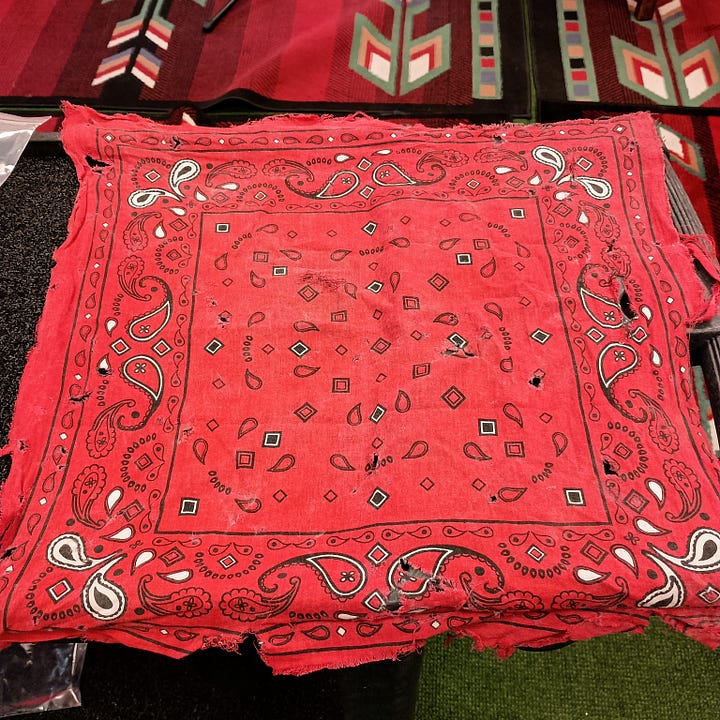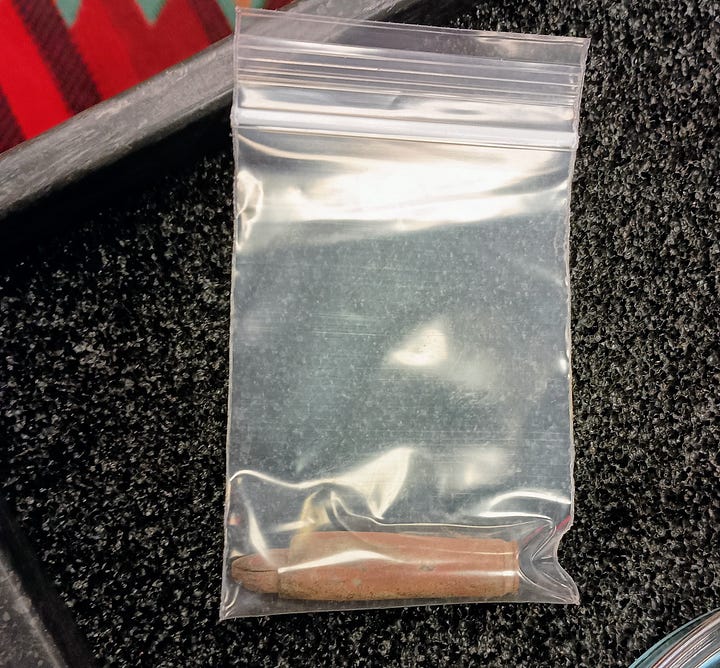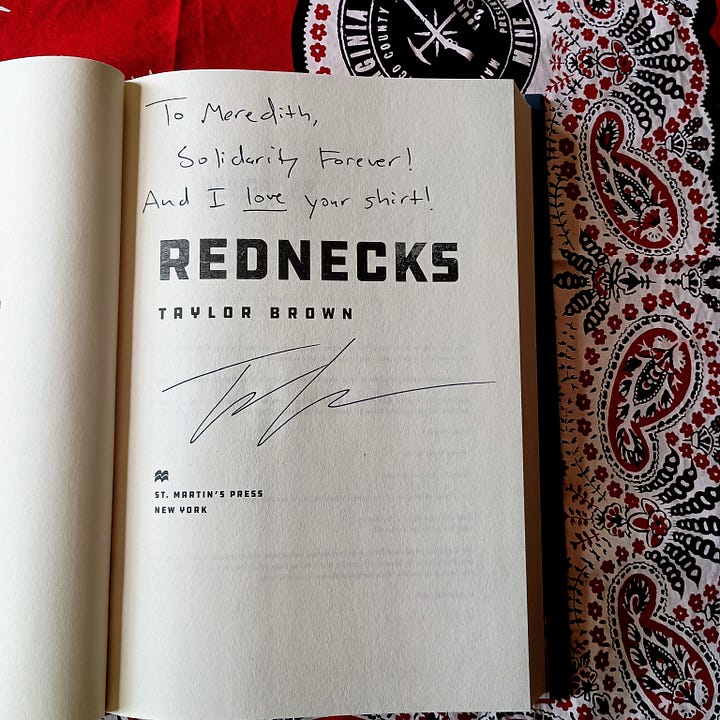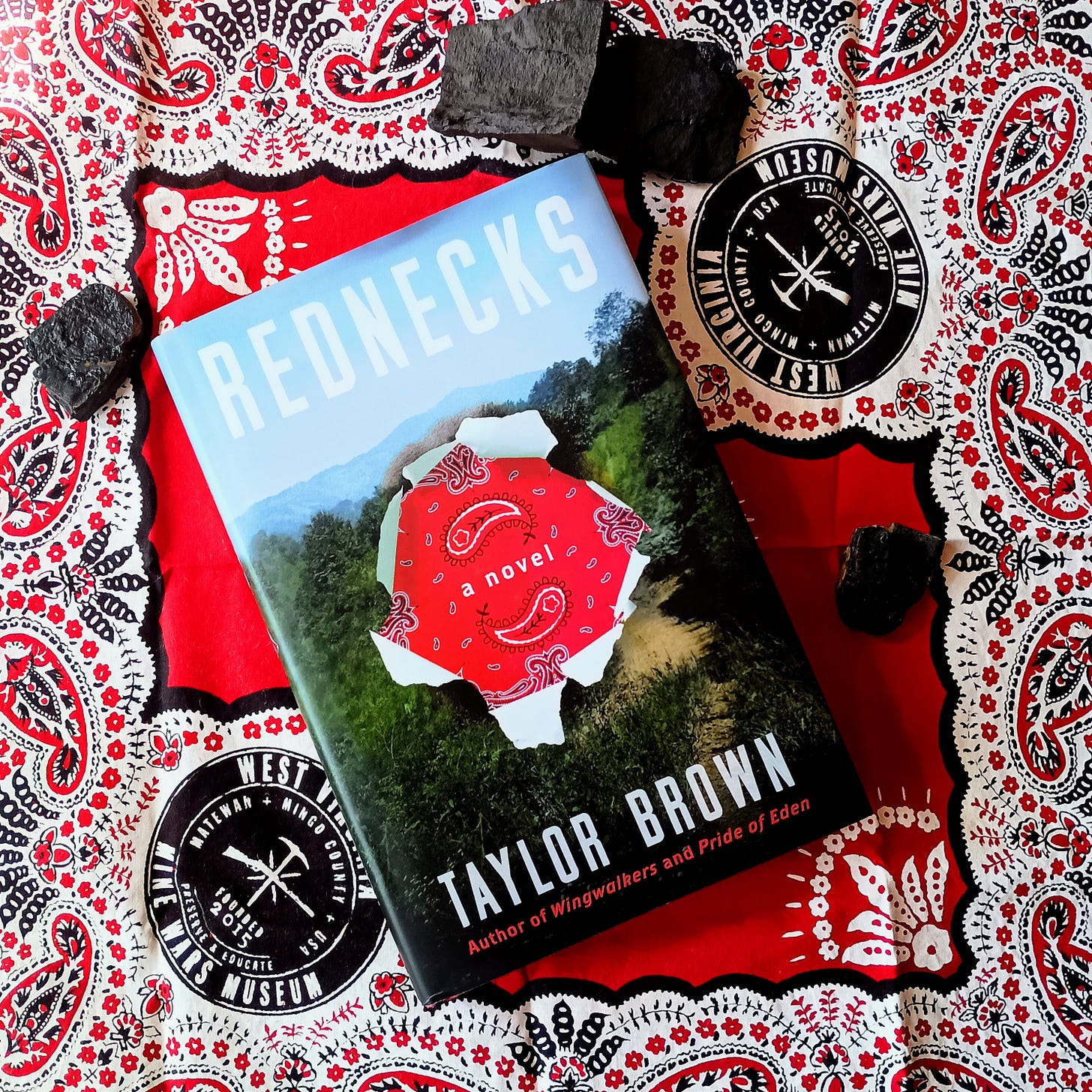Title: Rednecks: A Novel
Author: Taylor Brown
Narrator: Ramiz Monsef
Publisher: St. Martin’s Press
Publication Year: 2024
ISBN: 9781250329332 (physical), 9798892730815 (audio)
Rating: 5 stars
I have been very excited for this book to come out for a while now. It finally came out earlier this month and I got to read it and attend the book tour launch event at the West Virginia Mine Wars museum on May 18th (the day before the 104th anniversary of the Battle of Matewan).
I bought a hard copy of this book in the hopes that the author would sign it for me at the event (he did!) but I split the reading between the physical copy and the audio edition. I was hoping to finish the book before the event (sadly, I didn’t quite make that goal) so I wanted to be able to listen to it while I drove to Matewan. It’s not unusual for me to read a book this way—I like to split it so that I can read in my preferred medium when I have time to sit down and hold a book, but so that I can stay in the story when I’m doing other things like chores or driving that don’t allow me to keep my eyes on the page.
The Book
The book is fiction, but it follows the story of the Mine Wars from the Battle of Matewan through the Battle of Blair Mountain. It includes real life characters like Mother Jones, Bill Blizzard, and Sid Hatfield, but also characters invented by the author like Dr. Muhanna, Big Frank, and Miss Beulah, some of whom are loosely based on real people.
The story is told in third person perspective, but switches through the points of view of most of the main characters so the reader gets to see multiple interpretations of the conflict. Brown also does a really good job of showcasing stories from the Mine Wars that we don’t often get to hear. The WV coalfields were extremely diverse in the 1900s and 1920s. One in five miners was black and one in three miners was born outside of the US. However, due to archival racism, most of the photos and written records preserved at the time were those of white, American-born miners and so our records don’t tell the whole story. This book works to set the records straight and show more accurately the ethnic diversity of this labor movement. Dr. Muhanna is based on the author’s great-grandfather, a man who left Lebanon as a teenager and graduated from the University of Kentucky with a medical degree. Brown’s great-grandfather wasn’t actually a part of the Battle of Blair mountain like Dr. Muhanna, but he lived and worked in rural Kentucky and would have treated people very similar to the people in this book. Big Frank was based on Few Clothes Johnson and Frank Ingham. He is a black miner who is severely beaten by Baldwin Felts detectives and fights hard for the cause up until the bitter end. Miss Beulah is Frank’s grandmother who raised him. She was born into slavery, lived through the sacking of Atlanta and reconstruction only to lose a husband and son to coal mining and have her grandson’s life threatened by the same. In these ways, she is representative of so many women in the coal camps.
To be completely honest, when I found out Brown was a Georgia native, I was a little nervous about how this book would turn out. As a West Virginian, I have seen West Virginia stories done dirty in literature so many times. Not that only West Virginians can tell these stories, but often they tell the stories with more compassion and accuracy than outsiders. I’m happy to say my anxiety was for nothing. While Brown is not a West Virginian and didn’t learn about the Mine Wars until he was an adult, he really did his homework. This book is thoroughly researched and written with an understanding and compassion that warmed my heart.
However, I was a little disappointed in the audio production. For the most part the audiobook is good and I didn’t feel like the accents were overdone or hokey. However, the Guyandotte River features prominently in the climax of the story. Here, it is pronounced like guy-an-dot. In the audiobook, the narrator pronounces it guy-an-dotty and it drove me crazy. I even checked the physical edition to see if it was spelled differently to show dialect or something. Nope, it’s spelled correctly. I know it’s hard to be accurate 100% of the time and this audiobook had far fewer mispronunciations than the audiobook of Death in Mudlick (that one almost had me writing a letter to the publisher), but it makes me mad. The book had several European locations and words in other languages that all sounded pretty correct, but it’s the Appalachian locations that can’t be pronounced correctly. It is hurtful and makes me feel like big publishers aren’t taking Appalachian stories seriously. I just don’t think it would be too hard to get a pronunciation key before recording, especially for locations that are essential to the book.
The Launch Event




This event was the first stop on Brown’s book tour for the release of this book. It was perfect timing that he was able to start the tour out in Matewan, a location central to the book, the day before the anniversary of the Battle of Matewan, the day the book starts.
The event was hosted on the second floor of the Mine Wars Museum. The museum just completed the purchase of the entire building in October of 2023, and have created a community room on the second floor where they host events like this one. They have had poetry readings and other book-based events before and usually record the events so that they are available online later. You can watch the book launch here. It’s a great and versatile space. It was the first time I had been up there and I can’t wait to see what they do with it in the future.
The event started with some remarks from the staff of the museum about what they are up to and some music played by one of the staff members. Brown (right in the picture above) did a reading from chapters one and two of the book and the reading was followed by a Q & A moderated by Shaun Silfer the creative director (left in the picture above). Also joining Brown was his friend Jason Frye (center in the picture above). Fry is a freelance editor and writer, but more importantly he is from Logan, West Virginia and he is the one who brought the story of the Mine Wars and the Redneck Army to Brown’s attention.
After hearing the story from Frye, Brown couldn’t believe that this is a story most Americans don’t know. It was the largest armed uprising in the US since the Civil War. Warplanes dropped bombs on civilians—how could this be left out of history books? Well, history is told by the victors (an idea referenced in the book) and the Redneck Army technically lost. However, despite their loss, it is labor movements like this one that have given us so many of the workers’ rights we enjoy today. But, The Man still doesn’t want us to get any big ideas from labor history, so the story was left out of history curricula.
From this discussion, Brown watched John Sayles’s Matewan (I had on my Matewan shirt, that’s what he’s referencing in the book inscription) and decided that this story needed to be told, especially, because as Frye pointed out, we are currently fomenting working conditions that could lead to another Blair Mountain.
Brown talked about his research methods and how he did the same kind of research for this book that he would have done for a non-fiction book. He felt that there wasn’t yet a book about the Mine Wars that is fiction but also includes real people from the movement (Denise Giardina’s Storming Heaven and W. Jeff Barnes’s Mingo are both fiction novels about the Mine Wars that include real people, but not to the same extent as Rednecks). He says he started from the roots up with artifacts from the war (many that he saw on the Mine Wars Museum’s social media pages) and found the story from there. Much like me, Brown was concerned about his authority to tell the story since he isn’t from the area, and so wanted to do enough research that he could tell the story in the most authentic way possible. He succeeded.
As anyone who has tried to research in West Virginia will know, a lot of our local history is preserved in families and communities and passed down through oral tradition. Brown quickly caught on to that and spent a lot of time visiting the sites he writes about in the book and talking to people and learning their stories the old-fashioned way. He talked about how it is hard to access Blair Mountain now because it is owned by a coal company and has security gates at all the obvious entrances. However, because Brown got to talking to some people about the motorbike he was riding around, he found a different way up the mountain and was able to visit the site—something he wouldn’t be able to do without local connections.
Overall, Brown’s purpose in writing this book was to reclaim the term “redneck” as a term of pride and not as derogatory. He also wants readers to realize that there are other sides to history that we aren’t told and that we should look for those kinds of stories to educate ourselves. Brown also hopes that this book will be inspiring to those still fighting for their rights today.
After the official Q & A was over, Silfer opened the floor for audience questions. Someone asked Brown if he’d ever been down in a real coal mine (not quite, he’d only been down in Beckley’s Exhibition Coal Mine) or if he’d ever been shot at for real (no) and then jovially offered to help him experience both if he wanted. Some classic West Virginia hospitality.
When all the questions had been answered, Silfer brought out a cart of artifacts for people to look at while waiting in line to get their books signed. He had some coal scrip and some bullet casings excavated from battlefields, but he also had a bandana that had been used at the Battle of Blair Mountain (pictured above). The bandana had been donated to the museum that very day by Eddie Harless, whose grandfather had carried the bandana in the battle. I thought that was really amazing. The cart also had a pencil nib that was crimped into a .30 caliber casing found at Adkins Fork just south of Blair (pictured in the bag above). This artifact was one of the ones posted to the Mine Wars Museum’s social media that captured Brown’s imagination. In the book, Big Frank needs to write a note and finds a tiny bit of pencil in his pocket. He crimps it into the casing to make it long enough to write with. Even though that part of the story was invented by Brown, it was really neat to see the way the story interacted with real artifacts and get to see the artifacts that inspired parts of the story.
I am always impressed with the work going on at the Mine Wars Museum (they just opened a super cool exhibit about the Battle of Matewan that you should check out) and this was a great event. I highly recommend watching the video linked above and checking out the book!



